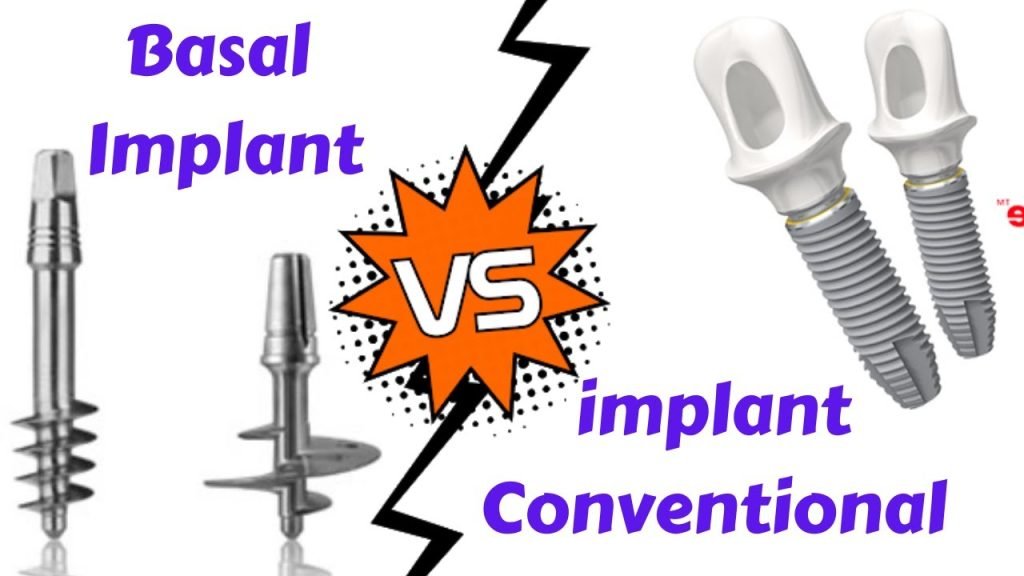
Single Piece Implants vs Two Piece Implants
Single Piece Implants vs Two Piece Implants : Choosing the right dental implant can be confusing, especially when it comes to deciding between single piece implants and two-piece implants. Many people feel unsure about which option to go for.
To help you understand the differences better, let’s compare these two types of implants.
Single piece implants are implants where the implant and abutment are combined into one unit they are also known as basal implants.
On the other hand, two-piece implants have separate implant and abutment parts they are known as conventional implants. They are approved by US FDA (United States Food & Drug Authority)
We will look at important factors and explain how these implants are different. This will make it easier for you to make a choice based on what’s best for your dental needs. Take a look at the table below that compares the key aspects of single piece implants and two-piece implants. It will help you see the advantages and disadvantages of each option.
One Piece Implant vs Two Piece Implant
| Aspect | Single Piece Implants | Two-Piece Implants |
|---|---|---|
| Design | Consist of a single integrated unit, placed at the same time | Two units first implant post is placed and then abutment is placed |
| Surgical Procedure | Requires a single-stage surgery | Generally involves a two-stage surgery |
| Healing Time | 15 days wound healing No bone integration time, needed with implant as implant is simply jammed in the bone | 15 days. Bone integration time needed as bone grows around Implants and implant becomes part of bone. 3-4 months typically |
| Stability | Generally provide good initial stability | Allows for greater control over implant stability |
| Final Teeth | Forced to be given immediately as abutment is visible about gums. No options for customization or changing angulation of final teeth as single piece. | Temporary teeth given immediately final teeth given after bone integration. A lot of flexibility because second piece is yet to come. Final teeth angle, shape size, can be changed easily as. |
| Adjacent Tooth Preservation | May require removal of adjacent teeth | Preserves adjacent teeth by utilizing abutment |
| Peri-implant Infections | Potentially more difficult to treat infections | Easier to address infections with separate components, simply remove the top portion and treat infection. |
| Bone Loss | Results in marginal bone loss over time | Helps minimize bone loss around the implant site |
| Esthetics | Severe limitations in achieving optimal esthetics | Provides enhanced esthetic outcomes with separate parts |
| Complication Management | If implants fails, complex surgery to remove it | Potential complications can be addressed separately, very simple to take out implant, unscrew it. |
What Should I choose Single Piece Implants vs Two Piece Implants
In conclusion, if you have severe bone loss and only hard basal bone remains, single piece implants should be considered as the last option for fixed teeth.
It is important to note that single piece implants are typically utilized in cases where traditional implant placement may not be feasible due to limited bone availability.
There are certain challenges to be aware of. Basal implants, for instance, may not have approval from the US FDA, and their long-term success is not well-documented.
On the other hand, conventional two piece implants have been approved by the US FDA and have a history of over five decades with extensive documentation.
In the unfortunate event of implant failure, removing basal implants can pose significant challenges. Therefore, it is recommended to consult with your dental professional and consider these factors when making a decision about the most suitable implant option for your specific needs.
Additional Information
- Comparison of Dental Implant Brands in India :: Center for Dental Implants & Esthetics
- Basal Implants vs Conventional Implants
- What are Different Types of Dental Implants
- Why you should avoid basal implants?
- Basal Implants: Understanding the Risks and Basal Implant Failure Rate
- Single Piece Implants vs Two Piece Implants
- How Dental Implants Stop Jaw Bone Loss
- What are Implant Failure Causes ?
- Single Piece Implants vs Two Piece Implants
- Dental Implant Surgery Risk [How to Avoid]
- How Dental Implants Work
- Basal Implants: Understanding the Risks and Basal Implant Failure Rate
- Checks before Dental Implant Surgery
- Questions to Ask Before Getting Dental Implants
- Dental Implant Healing Stages Unveiled
- All Dental Implants Questions Answered
- Comparison of Dental Implant Brands in India :: Center for Dental Implants & Esthetics
- Why you should avoid basal implants?
- What are Different Types of Dental Implants
- Single Piece Implants vs Two Piece Implants
- Basal Implants: Understanding the Risks and Basal Implant Failure Rate
- Basal Implants vs Conventional Implants
- Can I Get Dental Implants with Bone Loss?
- How Dental Implants Stop Jaw Bone Loss
- Single Piece Implants vs Two Piece Implants
- Can I get Oral Implants?
- Full Mouth Dental Implants [Procedure & Cost]
- Guided Implant Surgery or Digital Implants
- Understanding Peri-Implantitis : Causes, Symptoms, and Treatment
- Secrets of Finding Best Implants Dentist
- How Dental Implants Change Your Life
- Comparison of Dental Implant Brands in India :: Center for Dental Implants & Esthetics

Dr. Jyoti Singh (MDS), Diplomate WICO (Japan region) stands as a beacon of excellence in implantology within Delhi NCR region. She is a BDS and MDS(Prostho) both from Maulana Azad Institute of Dental Sciences, where she secured top honors with all India rank 1 in PG entrance examination. Her extensive experience at esteemed institutions like Clove Dental and her own Center for Dental Implants & Esthetics since 2016, Dr. Singh embodies unparalleled expertise in dental implants. Boasting a wealth of 16 years in dentistry and backed by 18 groundbreaking research papers in leading international journals (Google Scholar) and her ResearchGate profile, she epitomizes the pinnacle of proficiency and innovation in her field. She practices in Gurugram as your friendly dentist near me.
